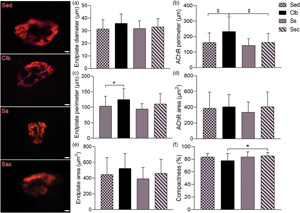Article contents
Morphological Changes in the Motor Endplate and in the Belly Muscle Induced by Previous Static Stretching to the Climbing Protocol
Published online by Cambridge University Press: 23 July 2021
Abstract

Static stretching provides benefits to the range of motion, modulates intramuscular connective tissue, and is incorporated into warm-up exercises. In this study, we present the effects in the motor endplate and belly muscle resulting from previous static stretching to climbing training. Twenty-four adult male Wistar rats were divided into four groups (n = 6 each): Sedentary (Sed), Climbing (Clb), Static stretching (Ss), and Static stretching prior to climbing (Ssc). The animals (Clb, Ss, and Ssc groups) were subjected to a training protocol 3×/week for 8 weeks, and the Ssc group was subjected to the Ss and Clb protocols in the same session. Samples from the animals were processed for immunostaining, histochemistry, and light microscopy. The Clb group presented a higher motor endplate; the Ss group presented no changes in the motor endplate; and the Ssc group demonstrated a higher compactness. We concluded that static stretching prior to the climbing protocol maintained the density of the motor endplate and increased the compactness of the neuromuscular junction structure. Also, there was a reduction in the myofibers’ diameter (Type I and IIa), an increase in myofibrillar densities (Type I and IIx, and total), and the reorganization of the myonuclei and the interstitium.
Keywords
- Type
- Biological Applications
- Information
- Copyright
- Copyright © The Author(s), 2021. Published by Cambridge University Press on behalf of the Microscopy Society of America
References
- 1
- Cited by



